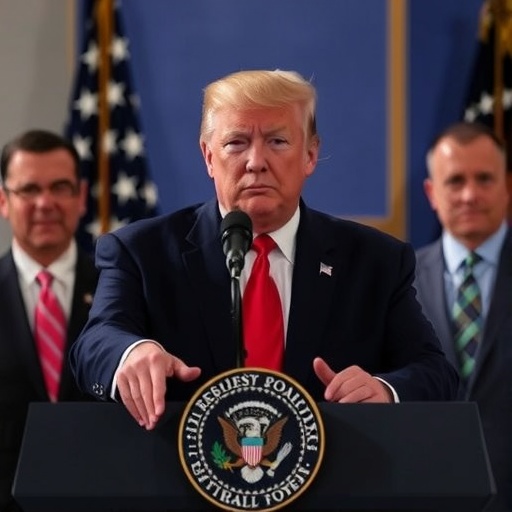Trump Administration Pushes for Mass Layoffs of Thousands of Federal Workers in Budget Overhaul
In a bold move that could reshape the federal workforce, the Trump Administration is proposing the layoffs of up to 50,000 federal employees, targeting departments long associated with Democratic policy priorities such as environmental protection and social services. This sweeping initiative, unveiled in a detailed budget proposal submitted to Congress on Tuesday, aims to slash federal spending by reallocating resources toward national security, infrastructure, and economic deregulation—core pillars of President Trump’s agenda.
The plan, which has already sparked fierce backlash from labor advocates and opposition lawmakers, represents one of the most aggressive workforce reductions in modern U.S. history. Officials from the Office of Management and Budget (OMB) estimate that these layoffs could save taxpayers upwards of $20 billion annually, but critics warn of devastating impacts on public services and employee morale. As the proposal lands amid ongoing economic recovery efforts post-pandemic, it raises urgent questions about the balance between fiscal efficiency and governmental functionality.
White House Press Secretary Kayleigh McEnany defended the strategy during a briefing, stating, “President Trump is committed to delivering a government that works for the American people, not against them. These reforms will eliminate waste and focus on what truly matters: jobs, security, and prosperity.” Yet, with implementation details still unfolding, the fate of thousands of federal workers hangs in the balance.
Departments Facing the Deepest Cuts Under Trump’s Plan
The Trump Administration‘s budget blueprint zeroes in on agencies perceived as bloated or misaligned with Republican ideals, with the Environmental Protection Agency (EPA) and the Department of Health and Human Services (HHS) topping the list for reductions. According to OMB projections, the EPA could see a 30% staff reduction, affecting approximately 5,000 employees involved in climate regulation and pollution enforcement. This comes on the heels of previous Trump-era rollbacks, but insiders describe the current push as “unprecedented in scope.”
Similarly, HHS, which oversees programs like Medicaid and public health initiatives, faces cuts to 15,000 positions, primarily in administrative and research roles. The rationale? Streamlining operations to prioritize pandemic response funding over what the administration calls “non-essential” oversight. A leaked internal memo from HHS Secretary Alex Azar highlighted that “duplicative roles in regulatory compliance will be consolidated,” potentially leading to widespread layoffs in regional offices across blue-leaning states like California and New York.
Other targeted entities include the Department of Education, where 10,000 jobs could be eliminated by devolving certain functions back to states, and the Consumer Financial Protection Bureau (CFPB), slated for a 40% workforce trim. These moves align with Trump’s long-stated goal of reducing federal overreach, but they disproportionately affect career civil servants who have served under multiple administrations. Data from the Office of Personnel Management (OPM) shows that over 60% of federal workers in these agencies are non-partisan professionals, many with advanced degrees and decades of service.
To illustrate the human element, consider the story of Maria Gonzalez, a 22-year EPA veteran based in Denver. “I’ve dedicated my career to protecting our air and water,” Gonzalez told reporters outside the agency headquarters. “Now, it feels like we’re being punished for the priorities of politicians we’ve never voted for.” Her sentiment echoes across forums and social media, where #SaveFederalJobs has trended amid growing anxiety.
Labor Unions Mobilize Against the Layoff Onslaught
Unions representing federal workers have wasted no time in mounting a robust defense, filing emergency lawsuits and launching nationwide campaigns to halt the Trump Administration‘s layoffs. The American Federation of Government Employees (AFGE), the largest union for federal workers with over 700,000 members, condemned the plan as “a partisan purge disguised as fiscal responsibility.” AFGE President Everett Kelley issued a statement vowing, “We will fight these cuts tooth and nail in the courts, on Capitol Hill, and in the court of public opinion. These aren’t just jobs—they’re the backbone of our democracy.”
Early legal challenges cite violations of civil service protections under the 1978 Civil Service Reform Act, arguing that mass layoffs without individualized assessments could breach due process. Labor experts predict a protracted battle, with the first hearings potentially slated for next month in federal district courts. Meanwhile, the National Treasury Employees Union (NTEU) has organized virtual town halls, drawing thousands of participants who shared stories of financial hardship. One union organizer in Washington, D.C., noted that preliminary polls among members show 85% opposition, with many considering early retirement or relocation if the plan proceeds.
Democratic leaders in Congress are amplifying these voices. House Speaker Nancy Pelosi labeled the proposal “vindictive and shortsighted,” promising oversight hearings in the House Appropriations Committee. Senate Minority Leader Chuck Schumer added, “This isn’t about saving money; it’s about settling scores. We’ll use every tool to protect these essential workers.” Bipartisan support, however, remains elusive, as some GOP lawmakers quietly endorse the cuts for their potential to curb the $28 trillion national debt.
From a statistical standpoint, the federal workforce currently stands at about 2.1 million civilian employees, down 5% since Trump took office in 2017. If enacted, these layoffs would accelerate that trend, pushing the total reduction to nearly 10% in under five years—a pace unseen since the post-World War II demobilization era.
Trump’s Broader Strategy: Reshaping Government for Economic Revival
At its core, the Trump Administration‘s push for federal workers layoffs is embedded in a larger vision to retool the government machinery for what officials describe as an “America First” economy. Budget Director Russ Vought outlined in a recent op-ed for The Wall Street Journal that reallocating $20 billion from “outdated programs” would fund initiatives like border wall expansion, veterans’ healthcare enhancements, and tax cuts for small businesses. “We’re not cutting for cutting’s sake,” Vought wrote. “We’re investing in winners and divesting from losers.”
This strategy builds on earlier efforts, such as the 2018 executive order promoting “Schedule F” reclassifications, which made it easier to fire policy-influencing employees. Although that order was partially rolled back, the current budget revives similar mechanisms, proposing to convert up to 50,000 positions to at-will employment status. Proponents argue this flexibility will boost efficiency; a Heritage Foundation report commissioned by the administration claims potential productivity gains of 15-20% in affected agencies.
Economically, the plan ties into Trump’s post-COVID recovery blueprint, emphasizing deregulation to spur private-sector growth. For instance, trimming EPA staff could expedite permitting for energy projects, aligning with the administration’s goal of achieving energy independence by 2025. Supporters, including the U.S. Chamber of Commerce, have praised the move, with CEO Thomas Donohue stating, “Streamlining the federal bureaucracy is key to unleashing American innovation.”
Yet, skeptics point to unintended consequences. A Government Accountability Office (GAO) analysis from last year warned that abrupt layoffs could lead to service disruptions, citing the 2013 sequestration’s impact on national parks and air traffic control. With unemployment still hovering at 6.2% nationally, adding 50,000 displaced federal workers to the job market could exacerbate regional downturns, particularly in D.C. and surrounding areas where government jobs dominate.
Personal Toll: Stories from Federal Workers on the Brink
Beyond the numbers, the proposed layoffs are upending lives across the country. In Atlanta, where the Centers for Disease Control and Prevention (CDC) employs over 10,000, epidemiologist Dr. Jamal Rivera faces an uncertain future. “I’ve spent years tracking infectious diseases, especially during this pandemic,” Rivera shared in an interview. “Losing my position now would not only hurt my family but weaken our national health defenses.” His household, like many, relies on his stable federal salary to cover mortgages and college tuition.
In Chicago, a Department of Housing and Urban Development (HUD) clerk named Lisa Chen worries about her aging parents. “These jobs provide benefits that private sector gigs often don’t,” she explained. “Layoffs mean more than pink slips—they mean losing healthcare and pensions built over 15 years.” Community support networks are emerging, with local nonprofits offering resume workshops and financial counseling tailored to federal workers.
Demographic data reveals the plan’s uneven impact: Women and minorities, who make up 45% and 35% of the federal workforce respectively, are overrepresented in vulnerable roles. The Partnership for Public Service, a nonpartisan advocacy group, estimates that 70% of affected positions are held by non-supervisory staff, many in mid-career stages ill-equipped for sudden unemployment.
Social media amplifies these narratives, with viral videos from laid-off workers in past rounds gaining millions of views. One TikTok campaign, #FederalFamily, features testimonials that humanize the policy’s stakes, pressuring lawmakers to intervene.
Outlook: Legal Battles and Congressional Showdown Ahead
As the Trump Administration presses forward, the path to implementing these federal workers layoffs is fraught with obstacles. Congress holds the purse strings, and with a divided Senate, passage of the full budget remains uncertain. Fiscal hawks like Sen. Rand Paul (R-KY) support the cuts, but moderates such as Sen. Susan Collins (R-ME) have expressed reservations, citing risks to essential services.
Looking ahead, experts anticipate a multi-phase rollout: Initial voluntary buyouts could affect 10,000 employees by year’s end, followed by involuntary layoffs in 2022 if funding is approved. The Supreme Court may ultimately weigh in, given precedents like the 1995 Timbers case on federal employment rights. For federal workers, resources like OPM’s transition assistance programs offer some solace, but many are bracing for long-term career shifts.
In the broader political landscape, this initiative could galvanize voter turnout in the 2022 midterms, positioning the issue as a flashpoint between small-government conservatism and protections for public servants. As one Hill staffer put it anonymously, “This isn’t just budget talk—it’s a defining battle for the soul of federal governance.” Whether the plan succeeds or stalls, its ripples will be felt for years, underscoring the high stakes of reshaping America’s bureaucratic heart.









